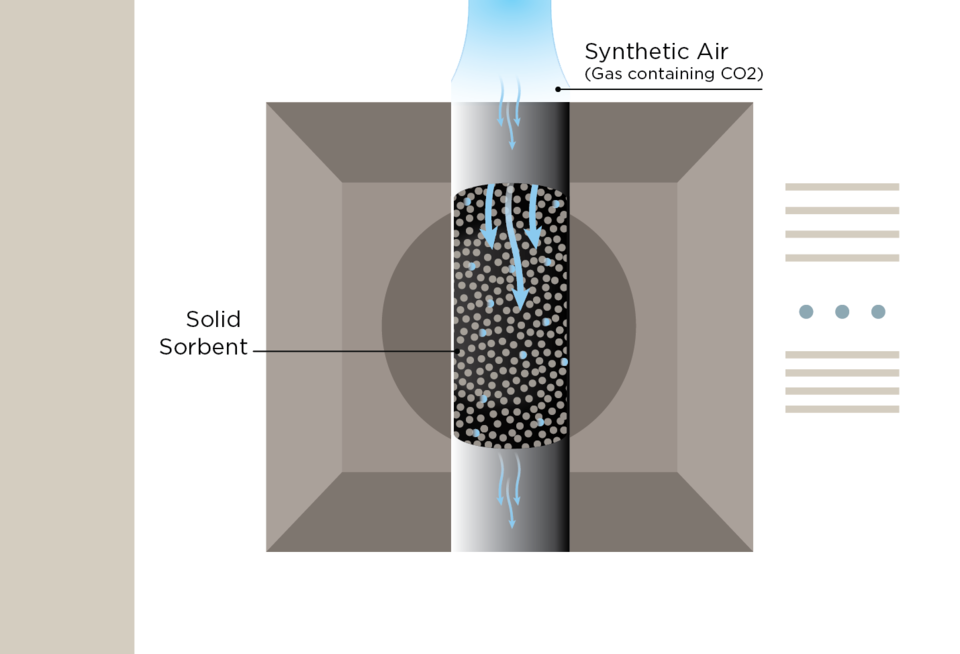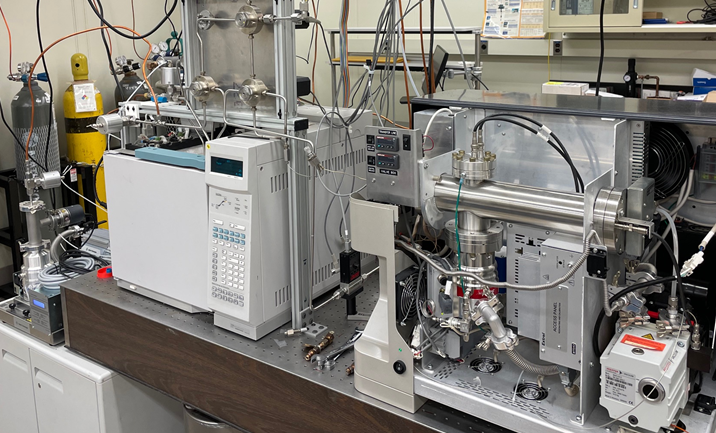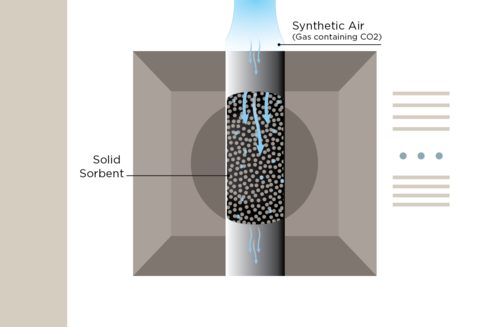
In a new carbon capture testing apparatus, synthetic air flows through a column. The sorbent traps and captures the carbon molecules. The device measures how fast the sorbent becomes saturated with CO₂.
N. Hanacek/NIST
More than 100 facilities designed to remove carbon dioxide (CO₂) from the atmosphere are in various stages of development around the world. In the United States, the first direct air capture (DAC) plant opened last fall in Northern California. The U.S. Department of Energy is funding four more regional DAC hubs with billions of dollars in seed money.
Now, the National Institute of Standards and Technology (NIST) aims to facilitate the development of this rapidly emerging technology that the International Energy Agency (IEA) says will be a "key technology" for combating global warming.
NIST scientists have developed a high-precision testing apparatus for benchmarking the performance of the materials, called sorbents, used in DAC plants to trap and remove carbon from the air.
The apparatus will enable the agency to develop research-grade test material (RGTM) sorbents for the DAC industry. These reference materials will be tested in the apparatus and validated to remove a certain amount of CO₂ from a given amount of air.

J. Manion/NIST
Companies will have the option of using the RGTMs to calibrate their equipment, making sure they get the same results as NIST does when they test the agency's materials. They can also use the materials as part of their research and development process, benchmarking the carbon-removal performance of their materials against NIST's.
"Our test and the RGTMs will allow for the critical and impartial evaluation of new, emerging DAC materials and a more comprehensive understanding of their performance," said NIST research chemist Sean McGivern. "We hope this will help advance the development of measurements and standards for the DAC industry."
Global warming results when greenhouse gases, including carbon dioxide, methane, nitrous oxide and fluorinated compounds, accumulate in the atmosphere. The gases absorb infrared radiation, leading to higher temperatures near the Earth's surface.
There are natural methods for removing carbon from the air, such as planting trees and soil restoration. Still, scientists believe additional approaches will be needed to fight global warming.
"We hope this will help advance the development of measurements and standards for the DAC industry." -Sean McGivern, NIST research chemist
Typically, DAC plants use giant fans to suck in air, which is then pushed through a filter containing sorbents. When heated (or through another method), the sorbent material releases, or desorbs, the carbon. The carbon can be buried deep in the ground or repurposed for industrial uses such as concrete and synthetic fuels.
Sorbents can either be solids or liquids. NIST's testing apparatus is only for solid sorbents, such as ion exchange resin, polymer-impregnated mesoporous silica (PIMS) and metal-organic frameworks (MOF).
The newly built DAC plant in California can remove a maximum of 1,000 metric tons of CO₂ per year, the equivalent of removing roughly 200 cars from the road. But by 2050, the IEA predicts many more DAC facilities will be built with the combined ability to remove nearly 1 billion metric tons of CO₂ per year.
"We need to scale this technology up by approximately six orders of magnitude to have the needed climate impact," says Pamela Chu, coordinator of NIST's Carbon Accounting and Decarbonization Program. "More research and development are needed to make this technology as efficient and economically viable as possible."
NIST's testing apparatus, first described in 2023 in the journal Industrial & Engineering Chemistry Research, is designed to put solid sorbents through their paces. Research chemist Jeffrey Manion, who helped create it, said it provides among "best-in-the-world measurements" to determine "exactly how well the material does in adsorbing carbon."

N. Hanacek/NIST
Here's how the testing apparatus works:
- Synthetic air - a combination of nitrogen, argon, oxygen, helium and CO₂ - is pumped into a box about the size of a home printer. Valves and controllers outside the box ensure the air flows with about the same force as the wind on a breezy day.
- Inside the box, the air is funneled into a thin column packed with a solid sorbent. The NIST team initially used zeolite beads, a mineral that attracts and captures CO₂ in the pores of its crystalline structure. They are now testing additional materials more commonly used in DAC plants.
- Beneath the column sits a mass spectrometer, an instrument that identifies gaseous molecules based on their molecular mass. It measures how much CO₂ passes through the sorbent rather than being adsorbed. The amount passing through increases over time as the sorbent becomes saturated and, like a water-logged sponge, can no longer capture CO₂.
- By analyzing the data gathered by the mass spectrometer, the researchers produce what's called a breakthrough curve, which plots how fast the sorbent becomes saturated with CO₂. This provides a precise measurement of the sorbent's performance.
- NIST researchers are upgrading the apparatus to pipe in moisture to test sorbents under varying amounts of humidity to match real-world conditions.
For the RGTMs, the first of which are expected next year, NIST researchers will test sorbents commonly used in the DAC industry.
An RGTM is an early-stage reference material that can lead to a standard reference material (SRM), which is more thoroughly characterized and measured and comes with a certificate of analysis.
NIST research chemist Elisabeth Mansfield said the agency might eventually develop SRMs for DAC sorbents but, at this point, is working to provide the fast-growing and highly competitive industry with reference material as quickly as possible.
"Many companies right now are developing new types of sorbents," she said. "They will want to know they work in the lab before they scale up. These RGTMs will let them test their lab equipment and give them confidence in their measurements."






